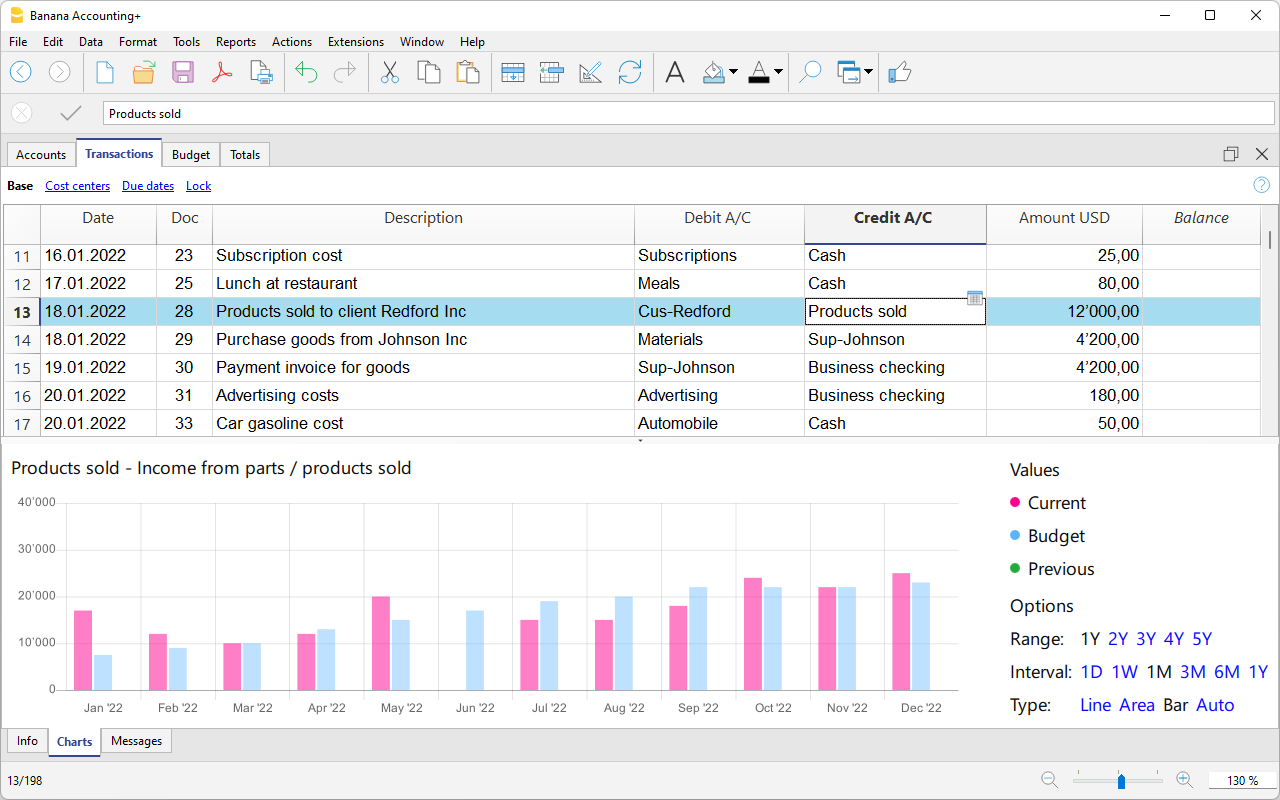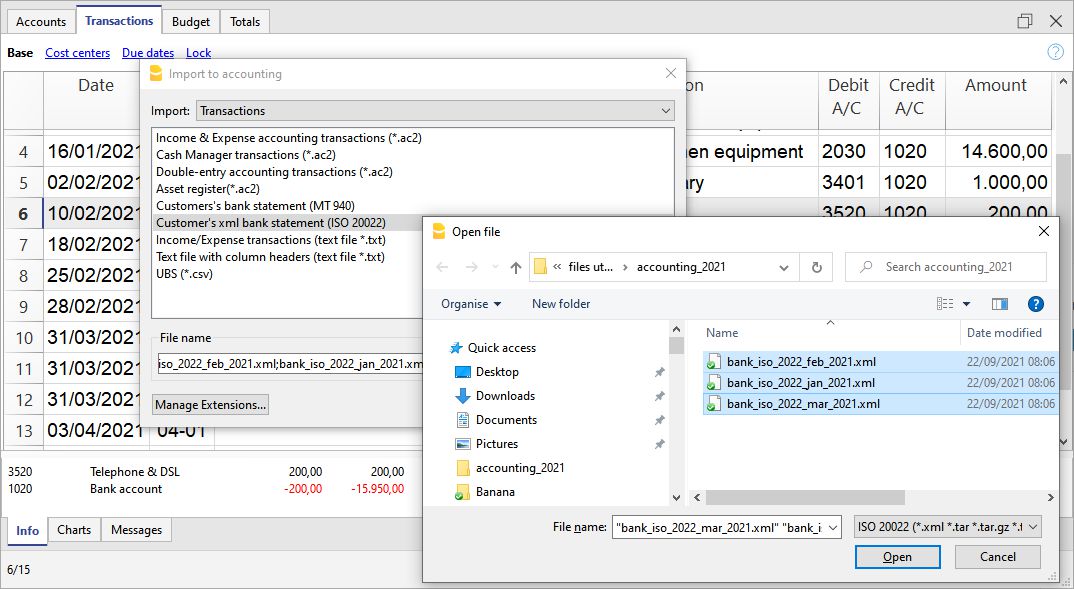In this article
For large companies that use ERPs (Enterprise Resource Planning), it is very inviting to employ Banana Accounting as a form of accounting data entry. Because of its simplicity, data-entry can be assigned equally to people who do not have accounting training or ERP systems, and because of its flexibility, one can easily integrate data in electronic format and have specific financial statements, which allow more precise cost control.

To give an understanding of the possible ways of use, we present three use cases. The advantages are explained and additional information is given further below.
Cantonal school budgets
In each school, one person registers the transactions, collects the receipts, and reconciles the accounts with Banana Accounting. The chart of accounts is created using a preset scheme, but then each school adapts it to suit its own needs and can thus have statements for individual classes or other expenses. Those responsible are consequently able to improve the management of their budgets and perform audits of the accounts management
At regular intervals, a statement is then printed or exported which is used to update the centralised accounts. This statement uses the accounts in the centralised system and groups the expenditures for the period, so that data integration is easy. However, the detailed data is on the internal network, so even at the central level all accounting information can always be accessed.
Accounting for projects of large humanitarian organizations
A number of humanitarian organizations, operating in different nations around the world, employ Banana Accounting to handle individual project accounting directly on site. Local accounting is set up using a standard template that is then adapted to the specifics of the individual project. Sometimes the accounting is handled directly in the local currency and following the standards for bookkeeping in the individual nation, thus without the need to adapt the centralised accounting system.
The budget that has been allocated for the project is also entered. Often projects are funded by third-party entities that require their own reporting. In this case, the chart of accounts is provided with the necessary cost centers to have additional reporting as well. Each project collects receipts, keeps accounts, and reconciles bank, cash, and liaison accounts with headquarters. Local management always has an up-to-date view of the financial situation and can have a comparison between the budget and what has already been spent.
Keeping accounts directly on site empowers people, allows local auditing, and is also much more efficient and less costly because staff costs less and can read the receipts in the local language. On a monthly, quarterly or even annual basis, a statement is exported with the accounts used in the centralised system. Accounting data from individual projects can accordingly be integrated without effort into the accounting system. There are organizations that import individual movements and others that import summary data.
Managing financial or offshore companies
Several large companies use Banana Accounting to manage the accounts of their subsidiaries, overseas branches, finance companies or foundations that are part of the group. Managing these accounts (perhaps in different languages, currencies or with different account structures) with the centralised system can be very complicated as well as very expensive in terms of licenses.
With Banana Accounting, the chart of accounts can be set up according to specific local needs. Bookkeeping and collection of receipts can be done directly on site by the people running the company or even by the central service that manages the subsidiaries. Banana Accounting statements are used for both compliance and management control. As needed, the accounting data is then imported or entered into the centralised system.
Advantages of using Banana Accounting
The main advantages of using Banana Accounting to manage separate accounts are:
- Accounting can be managed equally by people with no specific accounting training.
- It is similar to Excel, but the information is entered, structured and verified with accounting logic. You have higher quality data to be captured in the ERP system.
- Local entities can have financial control according to their own needs, without the need to customise the centralized accounting system.
- Each entity can adjust the chart of accounts as it goes along, without impacting that of other entities or requiring intervention from the central service.
- Needs, e.g., multi-currency accounts, local or specific reporting, that are not available on the central system can be addressed.
- Local accounts can be reconciled and verified much more easily locally.
- Headquarters, through data sharing systems, can access the accounts of each local entity.
- If there are changes of any kind, another entity is added and it is very easy to adapt.
- Any personal computer is enough to implement the solution; no special computer system is needed.
- There is no need to train staff to use complex systems.
- Only the people in possession of the accounting file have access to the specific accounting data, thus preventing legal compliance, confidentiality and security issues from arising.
- The cost of licensing and managing the solution is far less than any other solution. See the pricing of Banana Accounting Plus.
- The data to be integrated into the ERP are verified, reconciled and structured correctly.
Importing data from bank statements or other sources
Centralised systems are, for obvious security reasons, much more rigid. The integration of external data from bank statements or other sources, must be prepared very carefully by specialized technicians and after a whole series of tests have been carried out. Unfortunately, however, it is not always easy to automate the import of data, because formats may change or because it is better to have the data first verified, completed or corrected by hand. Also, sometimes it is only at the end of the period, while reconciling the data, that differences are discovered.
Importing data into Banana Accounting is much easier, because the person doing the accounting who has control over the situation, can edit and complete the data, and even undo the operation. One can open the import file in Excel, and then copy and paste it into the Transactions table. In certain situations keeping the accounting and reconciling the accounts in Banana Accounting and then integrating them into ERP can be the fastest and easiest solution.

Blockchain for accounting data alignment
Banana Accounting includes a patented accounting data certification system based on blockchain technology that allows you to be certain that transactions already imported into central accounting have not been changed, so that local and centralised accounting are perfectly aligned.
Customised reports and exports
Through extensions, tailored reports and exports can be created to facilitate and even automate the integration of accounting data into the central system. The extension as a rule verifies that there are no errors or differences, that the data is structured and formatted correctly so that integration can take place easily and securely. Banana Accounting is used in combination of the most important ERPs such as SAP, SAP Business One, Microsoft Dynamics, Oracle Financial, Infor, QuickBooks, XERO, Kingdee, YonYou, Abacus Research and many other solutions.